Galaxies - The Spiral Nebulae
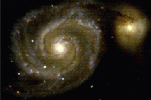

| Gene Smith's Astronomy Tutorial Galaxies - The Spiral Nebulae |
 |

The Spiral Nebulae
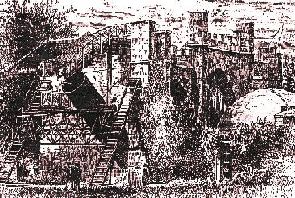 | In 1755 Immanuel Kant first speculated on philosophical grounds that there might exist "island universes" of stars like the Milky Way. In 1845, William Parsons, third Earl of Rosse, using a 72-inch home-built telescope at Birr Castle in Ireland, nicknamed the Leviathan of Parsonstown , determined that some of the nebulae have Spiral Structure and adopted Kant's term for them. |
| The Leviathan of Parsonstown |
The nature of the Spiral Nebulae was debated both literally and figuratively for the next several decades. A summation of the arguments was made in the Shapley-Curtis Debate (1920), between two eminent Astronomers, Harlow Shapley, then at Mt. Wilson and H. D. Curtis of Lick Observatory. Hubble detected Cepheid variables in Messier 31 - the Andromeda Galaxy - and other Local Group galaxies, establishing distances of hundreds of thousands to millions of light years.
Hubble Classification
Hubble also developed a classification scheme for galaxies which, with minor revisions remains in use today. Hubble divided galaxies into two principal catagories Elliptical and Spiral, with a third "Irregular" category left to catch those galaxies which defied regulae classification. Elliptical galaxies, which essentially consist of only a nuclear bulge component are subdivided among seven ellipticity classes from E0 (circular) to E7 (cigar shaped). Numerically the ellipticity is given by
Spiral galaxies are subdivided among three classes Sa, Sb, Sc, with a parallel sequence for Barred Spirals SBa, SBb, SBc . (More modern classifications add a class Sd and subdivide among the classes Sab, Sbc, Scd.) The three criteria are:
Tradionally the classification scheme is arranged in a "tuning fork diagram":
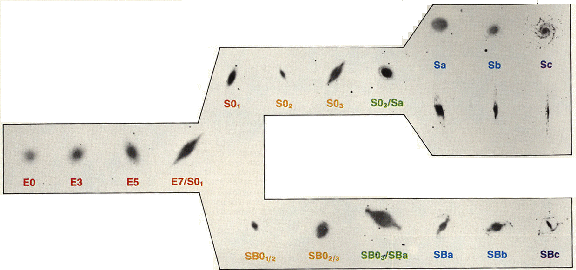
Virtually all of the observable characteristics of galaxies are directly related to their Hubble Classification as shown below:
| Galaxy Characteristics are Uniquely Related to Classification | ||||||
|---|---|---|---|---|---|---|
| E0-E7 | S0 | Sa | Sb | Sc | Irr | |
| Nuclear Bulge | "All Bulge" No disk |
Bulge & Disk | Large |  |
Small | None |
| Spiral Arms | None | None | Tight/Smooth |  |
Open/Clumpy | Occasional traces |
| Gas | Almost none | Almost none | ~1% | 2-5% | 5-10% | 10-50% |
| Young Stars HII Regions |
None | None | Traces |  |
Lots | Dominates Appearance |
| Stars | All Old (~ 1010yr) |
Old | Some young |  |
 |
Mostly(?) young (but some v. old) |
| Spectral Type |
G-K | G-K | G-K | F-K | A-F | A-F |
| Color | Red | Red |  |
 |
 |
Blue |
| Mass (M  ) ) |
108-1013 | (More) 1012-109 (Less) | 108-1011 | |||
| Luminosity (L  ) ) |
106-1011 | (More) 1011-108 (Less) | 108-1011 | |||
Here's a tuning fork composed of real galaxy images; click on the image to see a larger version, click on the name & Hubble Class to see more information about the galaxy from the SEDS Messier Database.
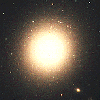 M87 - E0 |
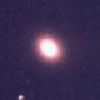 M110 - E5 |
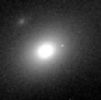 M86 - S0 |
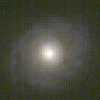 M94 - Sa |
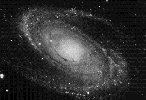 M81 - Sb |
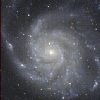 M101 - Sc |
Irregular galaxies come in two types:
 LMC - Irr I |
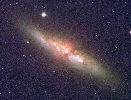 M82 - Irr II |
The unique relationship between the Hubble Class and other properties, most especially stellar populations suggests that the Hubble Class is fundamentally related to the way in which galaxies form and evolve. Originally Astronomers thought that the Hubble sequence might be an evolutionary sequence with galaxies evolving from right-to-left (or vice versa) along the tuning fork. This cannot be correct because to the best of our knowledge
It is clear, however that the Hubble sequence is a sequence in evolutionary state, however. For some reason Elliptical galaxies formed all their stars a long time ago, using up all their gas, so that new stars are no longer forming, there is virtually no young stellar population nor gas nor dust. Spirals, on the other hand, have retained much of their gas and are continuing to form stars. The answer is reminiscent of the Nature vs. Nurture debate occurring among biologists, psychologists & sociologists about human behaviour:
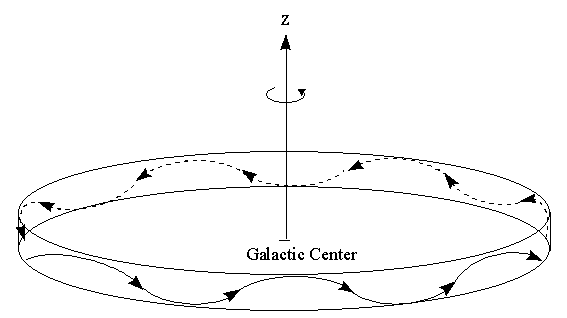 |
| Circular Orbits in a Spiral Disk |
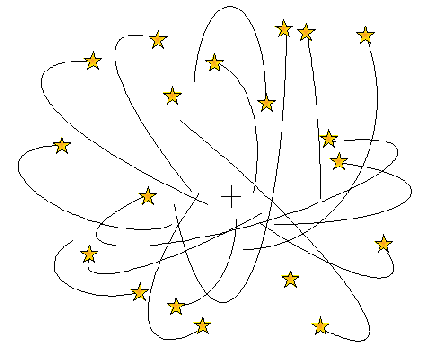 |
| Random Orbits in an Elliptical (or Spiral Bulge) |
It is quite likely that both effects play a role in determining the nature of
galaxies. Certainly collisions and mergers must play a role in the formation
of cluster elliptical galaxies. It seems almost certain, for example, that
the giant elliptical galaxies seen at the centers of rich clusters formed as
galaxies gradually accumulated at the center of the cluster's strong
gravitational field. While rotation probably also plays a role, especially
for disk (spiral and S0) galaxies, the history of the Milky Way suggests that
the contraction of the Galaxy to a disk was slower than had previously been
thought with accumulation of 106 -
108M fragments
forming first the bulge, then the halo and gradually settling down into
a disk due to angular momentum. The idea of this "bottom-up" accumulation
of larger galaxies from smaller fragments is also supported by current
calculations of the formation of structure in the early Universe. Our picture
of the formation of galaxies remains hazy, however, and much remains to be
understood.
fragments
forming first the bulge, then the halo and gradually settling down into
a disk due to angular momentum. The idea of this "bottom-up" accumulation
of larger galaxies from smaller fragments is also supported by current
calculations of the formation of structure in the early Universe. Our picture
of the formation of galaxies remains hazy, however, and much remains to be
understood.
Galaxy Links
Spiral Structure

![]() Clusters & Dark Matter
Clusters & Dark Matter
![]() The Distance Scale
The Distance Scale
![]() Education & Outreach
Education & Outreach
![]() CASS Home
CASS Home
Galaxy image credits & copyright: